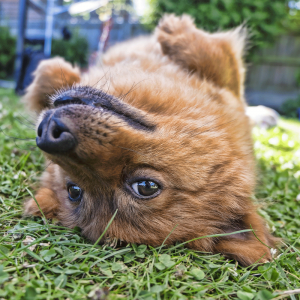In Part 1 of this blog, we looked at how to care for your dog during her pregnancy. In this second part, we’ll look in more detail at the whelping process, what to watch out for, and when to call for help.
What does normal whelping look like?
In most cases, the bitch will know when labour is imminent (although sometimes she may be mistaken, especially if she’s very young). 2-4 days before whelping down, she will become restless, and will seek out a secluded space to give birth – if you’ve set it up and introduced her to it properly, it will hopefully be your whelping area! In the 24 hours before whelping, her body temperature will drop quite markedly (as a result, it’s always useful to be checking her temperature several times during the day to get a “heads up”).
She will then go and nest in her preferred area and go into true labour. There are three stages in the bitch:
Stage 1 – During this phase, the bitch is lining up the puppies, ready to come out. It usually lasts 12-24 hours, but although her uterus is starting to contract, this isn’t visible from the outside. Usually, she’ll be firmly ensconced in her nest, refusing food at this point; and as it progresses, there may be a watery vaginal discharge as her cervix opens.
Stage 2 – this is the actual delivery of the puppy! There are visible and strong contractions, and she may pant or yelp. It shouldn’t last more than 2 hours, and in most cases less than one. The vaginal discharge in Stage 2 varies from clear, to red, to green – all are potentially normal! Often, Stage 2 contractions are weak and intermittent to begin with, but should then get progressively stronger and stronger.
Stage 3 – delivery of the placenta, or afterbirth, follows. In many cases, the bitch will eat this, although contrary to popular opinion it isn’t actually that important to her nutritionally. We’d normally expect this to take place about 15 minutes after the puppy.
Most bitches, most of the time, will deliver a puppy, then it’s placenta, then another puppy, then it’s placenta and so on. However, it’s not uncommon to get 2 or 3 puppies, then 2 or 3 placentas, then another puppy etc. It is important not to lose count – if you’ve got more puppies than placentas, it means one is still inside, and if not passed, it could establish a dangerous infection.
What complications might there be?
The vast majority of births go very smoothly. However, there are three common problems that you need to watch out for, as they are potentially fatal to puppies, and/or the bitch.
Uterine Inertia – this occurs when the puppies reach full term, the cervix opens… and then the bitch fails to push. There are a number of possible causes, including very small litter sizes (which may be why this is more common in smaller dogs). It can also be caused by slightly low calcium levels, or exhaustion, but whatever the cause, needs veterinary intervention.
Dystocia – failure to give birth, usually due to a puppy being stuck. This is a life-threatening emergency, and requires URGENT veterinary intervention to save the puppies and the bitch.
Eclampsia – dangerously low blood calcium. In most cases, this occurs a few weeks after whelping, but it may occur at the time, and trigger uterine inertia or dystocia. A key cause is excessive calcium in the diet in pregnancy, which means that the bitch’s body doesn’t regulate calcium as efficiently around the whelping and suckling periods, and allows it to fall too far. This presents as panting and restlessness, and so can be missed immediately before labour; it then, however, progresses to tremors, shaking, collapse and seizures or fits, and needs URGENT veterinary intervention.
What signs of trouble do I need to look for?
As a general rule of thumb, CALL US IMMEDIATELY if the bitch…
- Strains without producing any puppies for over an hour
- Fails to produce a pup two hours after the last one
- Hasn’t produced any puppies two days after her temperature dropped
- Is having forceful but intermittent contractions
- Seems exhausted or unhappy
How do I look after the puppies?
You shouldn’t have to – the bitch should normally know what she’s doing. If necessary, rub them gently with a towel to warm them up, but be careful – some bitches are very suspicious of people “stealing” their new puppies! Also do not shake them to get fluid out of their lungs (you can injure them), but if they aren’t breathing, gently tap their chests and CALL US for advice over the phone.
Make sure they all stay warm and on suck, and let the mother do her job; only if she isn’t may you have to intervene – in that case, call us IMMEDIATELY.
If you’ve got any other questions, feel free to call us for advice. If you think something’s going wrong, call us any time, 24/7, and talk to one of our vets.





